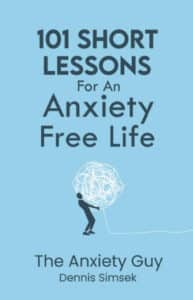To end negative thinking one must consistently present themselves with alternative options.
Let’s be honest, negative thinking can affect every aspect of a persons life. A person may get to a point in their lives where they start to believe that these thinking patterns are just normal. Soon, they wake up with them, drive to work with them, and find themselves highly pessimistic and engaging in catastrophic thinking more and more.
Why?
If we engage in what I like to refer to as ‘backtracking’ we can peel a few layers off these thinking patterns and see what’s really going on at a deeper level. Here are a few reasons for why someone unconsciously may not want to embark on a journey to end negative thinking. Or, why they hold themselves back from truly reversing this daily cycle:
- They may be following what their parents did, and therefore anything that contradicts these patterns feels like a loss of love for their authority figures.
- They may feel like negative thinking keeps them from further disappointment. They believe that if they think the worst consistently they won’t feel a sense of loss should the situation turn out badly.
- If they end negative thinking there may be a disconnect from their current social circle. One of the biggest reasons people don’t change is because of what they think others will think about them.
- It’s too unfamiliar. The world of the unknown is rarely travelled in an anxiety sufferers life since anything unfamiliar equals uncertainty. And we know how much certainty an anxiety sufferer needs, lots.
- It’s possible that they’ve attached their character to thinking this way. ‘It’s just who I am’ people will consistently say. As long as a person believes it’s who they are rather than something they’re doing, the road back to optimism will be a long and strenuous one.
Did some of these reasons create a ‘lightbulb moment’ in your mind? If so, you want to write them down and review them later on (a daily practice). Understanding why you do what you do at an unconscious level will free up the answers you need to end the negative cycle.
Here are 10 ways you can end negative thinking starting today:
1 – Use The Word ‘Or.’
The power of ‘or’ can’t be overlooked. Many times we fall for our negative thoughts rather than condition ourselves to counter them. When we counter these thoughts through the word or we open ourselves up to a new way of perceiving the situation. What’s important to remember though, is if a person is experiencing a highly level of emotion that’s connected to the negative thought, mentally challenging the thought might not work each time.
This is why it’s crucial to practice mindfulness around what’s taking place in your mind from moment to moment. This doesn’t mean you have to be obsessively tracking every thought though. You just have to be aware of when you’re giving one thought more attention than other ones throughout the day. Here’s an example of how to use the word or in your everyday life:
‘I always think that my symptoms of anxiety are serious physical ailments!’ OR, ‘I’m currently going through a sensitizing time in my life and my stress response is over-active.’
2 – The 1 Minute Reframe.
Take a 1 minute ‘time out, close your eyes, and imagine the BEST possible result showing up instead of the worst. Focus on what you can see, hear and feel, get your senses engaged as you run the movie of what you’d like to see take place in your minds eye instead.
One of the most important skills I recommend to my clients going through my anxiety recovery programs is the ability to consciously imagine. The opposite of consciously imagining a more pleasant outcome is unconsciously imagining. This leaves your perceptions of any future event in the hands of the inner wounded child within you that’s gone through developmental traumas in the past. When you consciously imagine, you’re literally holding the hand of your inner child and showing them what’s possible.
3 – Fix Your Posture.
Your physiology affects your psychology. How you look determines how you feel. You are literally sending safe or threatening signals to your nervous system from moment to moment depending on your posture. Social psychologist Amy Cuddi (in an excellent Ted Talk on Youtube) has done the science behind this. More specifically, she refers to something called ‘power poses’ and tells us that if we hold a certain bodily pose for 2 minutes our systems relax 20-40% more. With those kinds of stats we can’t overlook our postures.
Depressed people look depressed (hunched over constantly). Anxious people look anxious (constricting their inner organs and tightening up). Empowered people look empowered. Your posture dictates which thoughts you entertain more than others. So take this seriously, and understand that it takes daily practice to master your posture, but it’s well worth it in the end.
4 – Meet Daffy Duck!
In this video on my YouTube channel I refer to a skill set I like to call ‘changing the tone.’ This response that will help to end negative thinking simply gets you to listen to the unhelpful idea in the tone of a funny cartoon character. The steps for this are:
- Close your eyes and take a deep breath.
- Come face to face with a cartoon character (I like Daffy Duck).
- Begin listening to the same negative idea in the tone of voice of that character.
You want to make sure you listen to the thought in that new tone of voice over and over until you meet two goals:
Boredom and disinterest around the old negative thought.
When you feel like your respect for the limiting idea has lessened, and you sense that you can accept a new perception over the situation, you can stop listening and open up your eyes.
Since we’ve already created an association from when we were kids around cartoon characters, this works beautifully. I mean, who’s going to take anything that Goofy, Daffy, Tasmanian Devil (although he may need some coaching as well) seriously? I know I wouldn’t.
5 – Listen At A Distance.
One of the biggest roadblocks to end negative thinking comes down to how we hear these idea in our heads. When we can alter the tone, the distance etc of the limiting idea we become more disinterested. When we become more disinterested we give more attention to a new idea, which in turn alters our core beliefs.
To listen at a distance all you have to do is imagine that the negative thought is coming from 20 meters away, and you can barely recall what’s being said. It doesn’t really matter who’s saying it, but it sounds like a whisper rather than a shout (which is how we normally hear our negative thoughts). This takes serious intention and focus. You mustn’t get distracted when applying this tool so make sure you have some alone time.
6 – 2 Minute Morning Release.
Every anxiety sufferer should be adding this to their morning routine. The steps look like this:
- Have a ‘release journal’ ready beside your bed to write in when you wake up. Also, set a timer for 2 minutes.
- Upon waking up write down all the pessimistic, negative, catastrophic ideas that come to mind. You want to make sure that your intention is that the more you write the more you’re releasing out of your inner world. Every word you write down is a release from the inside onto the outside. This connection is key.
- When your two minute timer goes off stop writing. Take your paper(s) and walk to the closest garbage bin. Slowly begin ripping up the piece of paper while simultaneously chanting (inside or out loud) the word ‘release!’
What you do in the first 15 minutes upon waking up is very important to end negative thinking.
You must plant the seed of who you’re looking to become, and the subconscious mind is very much open to direction during this time. Most people going through an anxiety disorder wake up and think, feel, do, and imagine the same things day after day. Their desires are for something different, but their actions are aligned with further anxiety.
Make sure that your habits are aligned with your conscious desires. You can’t want one thing and do another. The 2 minute morning release will set you up for a progress filled day and help you to end negative thinking for good.
7 – Spur On Doubt.
Have you ever noticed the type of questions people suffering from anxiety ask themselves daily? They include questions like:
- ‘Why does this always happen to me?’
- ‘Why does god hate me so much?’
- ‘How come my anxiety symptoms won’t just go away?’
- ‘Why am I such a failure?’
- ‘What if I fail?’
Ask yourself a better question and you’ll get a better answer.
What we want to do with this skill set to end negative thinking is to spur on doubt around the negative idea in our heads. Questions like these during the initial moments of fear and sensitivity will transform your outlook:
- ‘What am I still angry about from my past, and what haven’t I let go of yet?’
- ‘Who haven’t I forgiven in my life?’
- What are these bodily symptoms and emotions telling me?’
- ‘What must I improve on today to stay more optimistic in my thinking?’
- ‘Do people really care about what I say and do as much as I think they do?’
These are open ended questions that lead to answers that will boost your inner progress. Developing a new character/identity means to think, speak, and act in line with this new you. So check in with yourself from time to time and make sure your questions are supportive rather than harmful.
8 – Directional Breathing.
What happens when we start jumping from one limiting idea to the next? More specifically, notice what happens to your breathing. Shallow breathing turns on your fight, flight, freeze response causing you to feel like the current situation is much more threatening than it actually is.
Instead of directly responding to the negative thought, directional breathing focuses first on a targeted method that will eventually lead to a shift in thinking. This method identifies a bridge between the body and the thought, and anytime we can get the body involved we’re creating change at a much deeper level. The steps for directional breathing are:
- Breathe in for a count of 4 through your nose. As you breathe in send your safety colour and the breath directly to the area in your body where you’re holding the fear.
- Breathe out for a count of 4 through your mouth. Breathe out the colour that reminds you of negativity, fear etc. Intentionally move the distress out of your body with every exhale.
- Do this until you feel a positive shift.
As you can see, to end negative thinking doesn’t consist of just ‘thinking differently.’ We engage with our entire mind, body, spirit system to create lasting change.
9 – Reframe Your Past Traumas.
People ask me how many times I’ve reframed my past traumas, and my answer to them is well over 1000 times. If reframing isn’t a part of your daily toolbox for healing I don’t believe a person can ever alter themselves fully. It’s an absolute must. Many times we think that just because something happened in our past that it’s over. This is untrue.
There is an unlimited storage system within our brains and bodies called the subconscious mind. This subconscious mind runs your reality no matter what you consciously want. During childhood traumas (can’t remember these past events? Here’s why) we froze in helplessness. This freezing response led the nervous system to become overwhelmed. When this happens often a person finds that some parts of them simply stop working efficiently.
Anxiety sufferers many times share resulting symptoms they experience such as depersonalization, memory loss, and chronic fatigue. These are signals of past trauma that haven’t been re-negotiated, repressed emotions that haven’t been discharged, and people including themselves that haven’t been forgiven.
This video from The Anxiety Guy YouTube Channel (Please Subscribe Here) will help you to understand emotional reframing and your present anxiety better.
When you’ve fully understood how your identity gets created between the ages of 0-7, leading to beliefs about yourself and the world which ultimately turn into your thinking patterns, go through this video below:
10 – Act Backwards
I loved acting backwards during my healing journey, and still do. Acting backwards means to simply do things in an opposite manner to how you normally do them. Some examples include:
- Walking backwards around your house.
- When you get out of the shower drying yourself from head to toe, rather than toe to head.
- While brushing your teeth, brushing with your left hand rather than your right.
When this happens consistently you’re attaching what’s unfamiliar to safety. This is a world that must be explored consistently to end negative thinking for good. Acting backwards opens up the flood gates to perceiving what used to be scary in a different way. All of a sudden what once felt uncertain now feels mysterious, adventurous, and you become curious more than you become fearful.
Conclusion.
To stop negative thinking we must look deeper than just the thought itself. We must find out why we do what we do, and what makes us unconsciously believe that what we’re thinking is who we are. It’s not who you are. It’s programming, and you never had the say in how you were programmed until now.
I would recommend that you eliminate the attitude of ‘trying’ any of these suggestions to end negative thinking. Instead, own them. Add them into your daily life and look for opportunities to use them more and more often. Self doubt is because you’re unpracticed, that’s all. So start practicing and I look forward to hearing your anxiety success stories soon.




















I am having panic attacks almost daily. I will try anything to get to a better place. Unfortunately, I can’t afford your program at the present time.
Just make sure you’re not making these mistakes during the build and during panic attacks (Video): https://www.youtube.com/watch?v=MdI93mLTlAg&t=1s
Dr Claire Weekes in her books gives you minute by minute strategies to deal with panic. Self Help for Your Nerves and many others. Used along with Dennis Simsek’s brilliant advice I know you will recover quickly.
Great add on thank you Maureen.